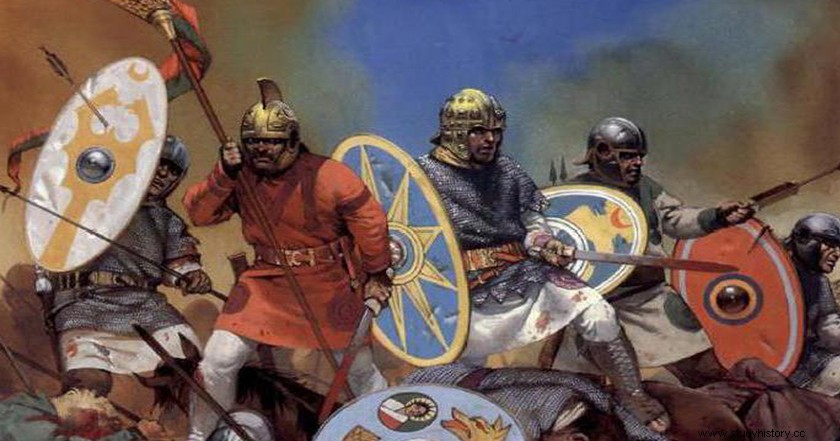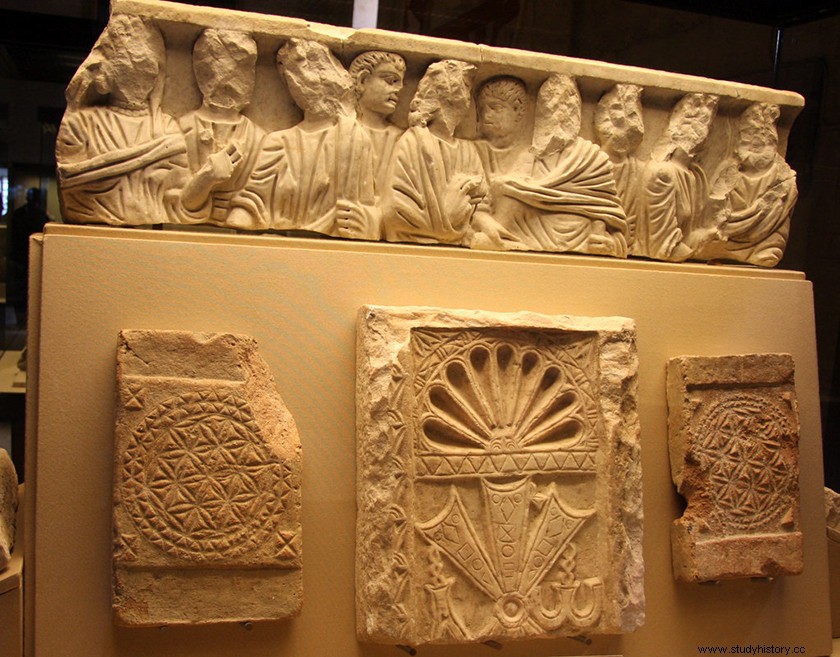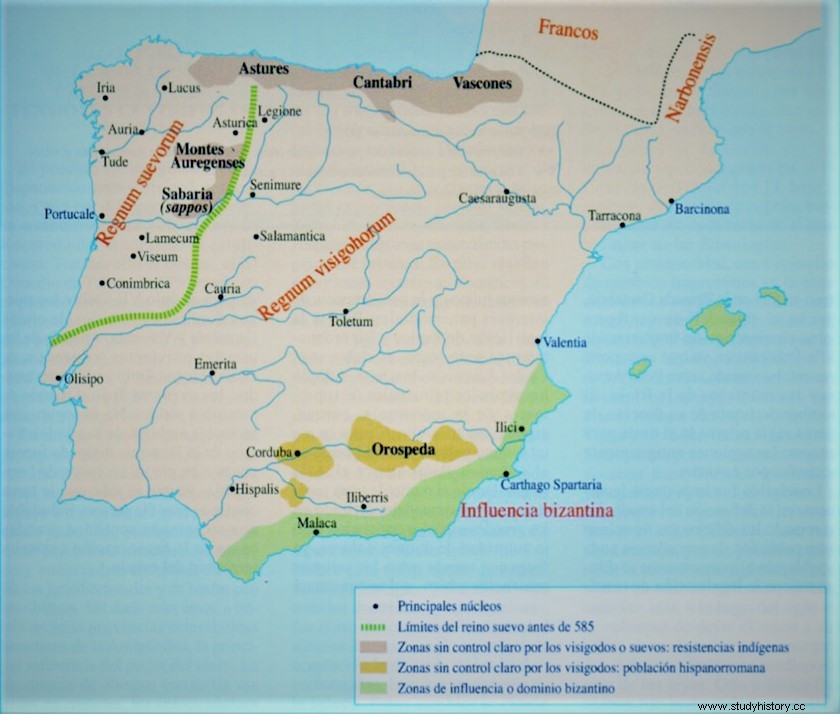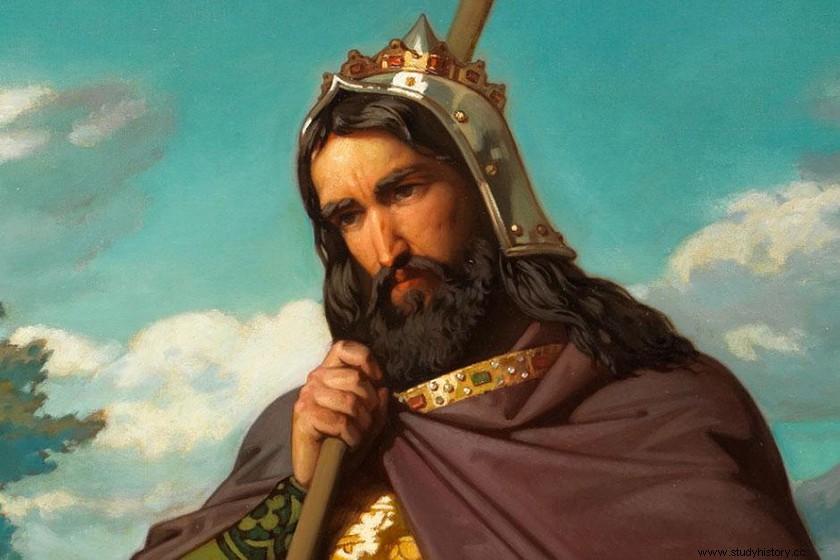
The Visigoth kingdom was the first political entity of a certain shaft, in the Hispania that was orphaned after the fall of the Roman Empire. A people, the Visigoths, of a marked military character that had emerged from the cold lands of the north, and that, upon reaching the Iberian Peninsula, had to continue fighting to settle. As an example, today we bring the difficulties that the Visigothic kings went through to conquer the rich Roman region of Baetica, headed by the powerful city of Córdoba.
The font problem.
Before getting into the matter, it is necessary to make a point; Very little is known about the Visigoths, hence, narrating some parts of their history, we can fall into errors or inaccuracies. There was not even one of them who deigned to tell the story of his people, or if there was, the Arabs took it upon themselves to erase it from the face of the earth with a stroke of the pen.
What we know about them comes, among others, from the Catholics who suffered their arrival in the Peninsula, for example, the Archbishop of Seville, San Isidoro, or the Lusitanian Juan de Biclaro. Other contemporaries who told us their story were foreigners such as the Frank Gregory of Tours, or the most important for this stretch of history, the Byzantine in the service of Justinian, Procopius of Caesarea.

The Archbishop of Seville San Isidoro
On the other hand, we cannot forget an essential fact, the Visigoths were more legislators than historians. Since the main writings that have come down to us from this period are the minutes of the councils held by kings, nobles, and clerics, who became true governing bodies of the Visigothic state. There were also those who tried, after the disintegration of said state, to keep their history afloat by rewriting it under the protection of the ancient legends transmitted orally and the aforementioned records. Of all of them, one stands out above all:the Asturian king Alfonso III, with the vindication of him as heir to the Visigothic kingdom. With all these pieces, current historiography has told us the details of the history of the Visigothic Kingdom.
The Visigoth court of Seville.
We began our story in an unknown palace in the city of Seville, the year was 549. The scene leaves no room for doubt, the last Visigothic king of Ostrogothic descent appears in the center , Teudiselo. His body looks like a colander adorned with various daggers, around him, a series of nobles with bloody hands look satisfied.
Who were these nobles? Now the doubts begin:According to San Isidoro de Sevilla they were disgruntled husbands with a good dose of horns. It seems to us that the Archbishop of Seville sought to discredit the Visigoth king. Subsequent events lead us to suspect two very different factions. On the one hand, those in favor of implanting a new king of Visigothic descent, and thus removing the Ostrogoths from power. On the other, the nobles of Baetica, the richest region of Hispania, who did not intend to continue supporting the newborn Visigothic monarchy with their profits.
It is necessary to emphasize the aspect of the wealth of Baetica. If today we were to look for clues about the convulsive sixth century in an Andalusian site, we would find materials very similar to those of the fourth or fifth centuries. That is to say, trade with North Africa followed its course as in the Low Imperial period, oil and the wine from Baetica continued to supply the Mediterranean markets. The same does not happen further north, since from the 5th century the imperial decadence leaves us with poor archaeological records, and a growing autarchy forced by the wars caused by the newcomers. The very imposition of the first Visigothic capital in Hispania in Seville, according to Procopius of Caesarea, is a more than significant reason that it was the richest province of the new Visigothic Hispania.
We return to the story to meet the replacement for the unfortunate Teudiselo. It is not clear what his motives were for rising to power, but Agila, an Arian through and through, seizes it. Among his virtues seemed to be the war and his determination against the Catholics.
Shortly after his appointment he heads against the city of Córdoba. We do not know details of the political status of this city, although it is to be assumed that it held a certain independence from the Visigothic central power. And especially economic, with its rich landowners exercising the power of the aforementioned Mediterranean trade. In addition, they were religiously in favor of maintaining Catholicism in the city. In short, they found themselves face to face with an Arian king with economic needs, and a city that did not want to lose its economic status, much less his religious preferences.

Visigoth remains found under the Cordoba mosque.
The result was a resounding defeat of the Agila. The troops in the service of the Cordovan nobles expelled the Visigoths, killed the king's son, and also stole Agila's Royal treasure from him. This last aspect is interesting to understand the problems that the Visigoths were having to establish themselves in Baetica. The lack of a fixed capital, presumably they had lost Seville, led them to have to transport their war treasure to war as in the past.
The Byzantine opportunity.
After the defeat, Agila retreats to the city of Mérida to see how a new power appears from Baetica to face. Atanagildo, a Visigothic duke, more in favor of understanding with the Catholics, and based in the city of Seville, proclaimed himself Visigothic king. Four years of civil war had just begun, the perfect excuse for a new claimant to take control of ancient Roman Hispania.
Justinian, the Byzantine emperor, and his project to reconquer all the territories lost by the Roman Empire, found a unique opportunity with the civil war between the Visigoths. After conquering Italy and North Africa, in the year 552, at Atanagildo's call for help, the Byzantines landed in Hispania. Commanding the small contingent was General Félix Liborio, a Byzantine military veteran, former prefect of Gaul, who did not hesitate to join his forces with those of the new Visigothic king, to defeat Agila's troops besieging Seville. /p>
The Byzantine army should not have intervened many more times in the proposed civil war. Between the years 552-555 the Visigoths bled to death among themselves, before the impassive gaze of the Byzantines who were taking over all the coastal cities of southern Hispania. We can think that the inhabitants of Baetica preferred to pay tribute to a Roman Christian, than to an Arian who arrived from the north.
Atanagildo and the Visigoths on the razor's edge.
Finally Agila suffered the same fate as his predecessor, apparently killed by his own battle-weary men. After this death, Atanagildo took sole control of the Visigothic state. Seen in perspective, the gift of the men of Agila seems difficult to digest.
The Visigoth kingdom was on the brink of a precipice. The Visigothic armies decimated, and the state in total bankruptcy with no possibility of recovering the royal treasure lost in Córdoba. As if their own problems were not enough, behind the borders of the Visigothic state, a lot of neighbors willing to take advantage of Visigothic weakness. The Byzantines controlling the Mediterranean trade, Córdoba protected by the pacts with the former, to the northwest the Swabians who intended to become Catholics to join the Byzantines, and finally the completely independent Cantabrians, Asturians and Basques. Faced with such a scenario, if the Visigoths stood up, it was because they were a determined people.
It cannot be said that Atanagildo neglected military campaigns. There is evidence of various attempts to expel the Byzantines from the main Mediterranean cities, Cartagena or Malaga. The control they exercised from Seville is also known, thanks to the nobility of the area, a supporter since his time as Duke of Bética. Although the conquest of Cordoba continued to be its Achilles' heel, meeting again and again with the opposition of its citizens, possibly supported by the Byzantine neighbors. All these battles continued to undermine the very poor Visigoth coffers.
But in the twelve years of Atanagild's reign between the years 555-567 it was not all bad news. He had the right decision to take the capital to Toledo, from that moment and until the Arab invasion the main city of the Visigoths in Hispania. The Frankish neighbors from the north arrived at the court installed there in search of the Visigoth princesses, Brunilda and Galsvinda, to turn them into queens of some Frankish states. This aspect makes us think that the Visigothic prestige was still intact, especially in Septimania, his first place of residence after emigrating from the Balkan area, at the beginning of the 5th century.

Septimania was the northernmost area of the Visigothic Kingdom.
After his death due to natural causes, another symptom of political stability, a duke of Septimania succeeds him. Liuva is proclaimed by his men the new Visigoth king. We cannot deny that the decision was strange, since the election was consensual far removed from the true center of power in Toledo. But one aspect tells us that possibly there were very important consensuses among the highest Visigothic nobility. The Septimania was close to entering a crisis, the Franks soon forgot about the marriage pacts, intending to attack the north of the Visigothic kingdom. It is in this context where the most successful decision of the Visigoths arises; Liuva appoints his brother Leovigildo as successor, and sends him to govern the Hispanic part of the kingdom from the capital of Toledo.
Leovigildo the conqueror of Córdoba.
As soon as he came to power and while his brother took care of the northern border, Leovigildo got down to business. Two firm purposes appear on the agenda of the new tenant of the Visigothic court of Toledo.

Map of the Peninsula in times of Leovigildo
The first to give prestige to the Visigothic monarchy to put it on a par with its Byzantine neighbors. This happened by copying his ceremonial; the king was to dress in purple, enthrone himself with a golden crown, and receive his subjects on a sumptuous throne. The second of the projects was even more ambitious; gather and subdue all the peoples of the Peninsula under the same man, obviously the same. It was clear that to achieve both purposes he needed large financial resources, but it was also clear that he knew where they should come from.
The conquest of Córdoba needed a good preparation. This happened to isolate her from her faithful allies the Byzantines, who fortunately for Leovigildo were not going through their best moment. They had recently lost control of Italy and North Africa, so the isolation was a wonderful opportunity for the Visigoths to further weaken their enemy.

Leovigildo
In the year 570, Leovigild sets out to begin pillaging the Byzantine province. The chosen place is the rich Malaga, if he conquered it he would be able to split the province in two, which would cause a hindrance in communications between the military garrisons. He did not achieve his goal, but at least he began to fill the Visigoth coffers with various spoils from the peripheral cities of the capital of Malaga. Somewhat more successful was Leovigildo in the following year's expedition to Medina Sidonia. The imposing castle inherited from the Romans was a magnificent watchtower to control the western part of the Byzantine province. Well, for some unknown reason one of the Byzantine guards opened the gate of the fortress, the Visigoths entered and finished off the garrison protecting the castle.
Faced with these Visigoth incursions into Byzantine territory, we can think that the latter had lost much of their offensive potential, leaving the capture of Córdoba in the hands of the Visigoths. According to the sources it was in one night, the high nobility soon surrendered their arms before the new power that was coming. The city was sacked, the royal treasury largely recovered, and new taxes were soon imposed on the nobles of Baetica. Now Leovigildo already had the economic resources that he needed, successively the Suevi, the Astures, the Cantabrians or the Vascones fell. At the death of the Visigothic king in the year 586, only a narrow maritime strip was in the hands of the last Byzantines of the Peninsula.
More info:
Ancient history of the Iberian Peninsula, late imperial and Visigoth times, J. J. Sayas Abengochea and Manuel Abad Valera, Ed. Uned 2013
Brief history of the Goths, Fermin Miranda García, Ed. Nowtilus, 2015
Visigoths, José Javier Esparza, Ed. Sphere of books, 2018
